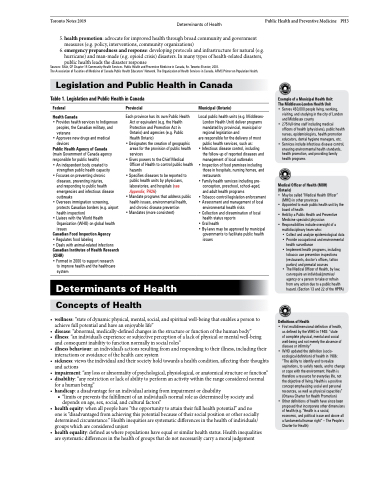Page 1221 - TNFlipTest
P. 1221
Toronto Notes 2019 Determinants of Health
5. health promotion: advocate for improved health through broad community and government measures (e.g. policy, interventions, community organizations)
6. emergency preparedness and response: developing protocols and infrastructure for natural (e.g.
hurricane) and man-made (e.g. opioid crisis) disasters. In many types of health-related disasters,
public health leads the disaster response
Sources: Shah, CP. Chapter 15 Community Health Services. Public Health and Preventive Medicine in Canada, 5e. Toronto: Elsevier, 2003.
The Association of Faculties of Medicine of Canada Public Health Educators’ Network. The Organization of Health Services in Canada. AFMC Primer on Population Health.
Legislation and Public Health in Canada
Public Health and Preventive Medicine PH3
Table 1. Legislation and Public Health in Canada
Example of a Municipal Health Unit: The Middlesex-London Health Unit
• Serves 450,000 people living, working,
visiting, and studying in the city of London
and Middlesex county
• 275 full-time staff including medical
officers of health (physicians), public health nurses, epidemiologists, health promotion educators, dental hygiene managers, etc.
• Services include infectious disease control, ensuring environmental health standards, health promotion, and providing family health programs
Medical Officer of Health (MOH) (Ontario)
• May be called “Medical Health Officer”
(MHO) in other provinces
• Appointed to each public health unit by the
board of health
• Held by a Public Health and Preventive
Medicine specialist physician
• Responsibilities include oversight of a
multidisciplinary team who:
• Collect and analyze epidemiological data
• Provide occupational and environmental
health surveillance
• Implement health programs, including
tobacco use prevention inspections (restaurants, doctor’s offices, tattoo parlors) and prenatal courses
• The Medical Officer of Health, by law, can require an individual/premise/ agency or a person to take or refrain from any action due to a public health hazard. (Section 13 and 22 of the HPPA)
Definitions of Health
• First multidimensional definition of health, as defined by the WHO in 1948: “state
of complete physical, mental and social well-being and not merely the absence of disease or infirmity”
• WHO updated the definition (socio- ecological definition) of health in 1986: “The ability to identify and to realize aspirations, to satisfy needs, and to change or cope with the environment. Health is therefore a resource for everyday life, not the objective of living. Health is a positive concept emphasizing social and personal resources, as well as physical capacities” (Ottawa Charter for Health Promotion)
• Other definitions of health have since been proposed that incorporate other dimensions of health (e.g. “Health is a social, economic, and political issue and above all a fundamental human right“ – The People’s Charter for Health)
Federal
Health Canada
• Provides health services to Indigenous peoples, the Canadian military, and veterans
• Approves new drugs and medical devices
Public Health Agency of Canada
(main Government of Canada agency responsible for public health)
• An independent body created to
strengthen public health capacity • Focuses on preventing chronic
diseases, preventing injuries,
and responding to public health emergencies and infectious disease outbreaks
• Oversees immigration screening, protects Canadian borders (e.g. airport health inspection)
• Liaises with the World Health Organization (WHO) on global health issues
Canadian Food Inspection Agency
• Regulates food labeling
• Deals with animal-related infections Canadian Institutes of Health Research (CIHR)
• Formed in 2000 to support research
to improve health and the healthcare system
Provincial
Each province has its own Public Health Act or equivalent (e.g. the Health Protection and Promotion Act in Ontario) and agencies (e.g. Public Health Ontario)
• Designates the creation of geographic areas for the provision of public health services
• Gives powers to the Chief Medical Officer of Health to control public health hazards
• Specifies diseases to be reported to public health units by physicians, laboratories, and hospitals (see Appendix, PH26)
• Mandate programs that address public health issues, environmental health, and chronic disease prevention
• Mandates (more consistent)
Municipal (Ontario)
Local public health units (e.g. Middlesex- London Health Unit) deliver programs mandated by provincial, municipal or regional legislation and
are responsible for the delivery of most public health services, such as:
• Infectious disease control, including the follow-up of reported diseases and management of local outbreaks
• Inspection of food premises including those in hospitals, nursing homes, and restaurants
• Family health services including pre- conception, preschool, school-aged, and adult health programs
• Tobacco control legislation enforcement • Assessment and management of local
environmental health risks
• Collection and dissemination of local
health status reports
• Oral health
• By-laws may be approved by municipal
governments to facilitate public health issues
Determinants of Health
Concepts of Health
• wellness:“stateofdynamicphysical,mental,social,andspiritualwell-beingthatenablesapersonto achieve full potential and have an enjoyable life”
• disease: “abnormal, medically-defined changes in the structure or function of the human body”
• illness:“anindividual’sexperienceorsubjectiveperceptionofalackofphysicalormentalwell-being
and consequent inability to function normally in social roles”
• illnessbehaviour:anindividual’sactionsresultingfromandrespondingtotheirillness,includingtheir
interactions or avoidance of the health care system
• sickness: views the individual and their society hold towards a health condition, affecting their thoughts
and actions
• impairment:“anylossorabnormalityofpsychological,physiological,oranatomicalstructureorfunction”
• disability:“anyrestrictionorlackofabilitytoperformanactivitywithintherangeconsiderednormal
for a human being”
• handicap: a disadvantage for an individual arising from impairment or disability
■ “limits or prevents the fulfillment of an individual’s normal role as determined by society and depends on age, sex, social, and cultural factors”
• healthequity:whenallpeoplehave“theopportunitytoattaintheirfullhealthpotential”andno one is “disadvantaged from achieving this potential because of their social position or other socially determined circumstance.” Health inequities are systematic differences in the health of individuals/ groups which are considered unjust
• healthequality:definedaswherepopulationshaveequalorsimilarhealthstatus.Healthinequalities are systematic differences in the health of groups that do not necessarily carry a moral judgement


